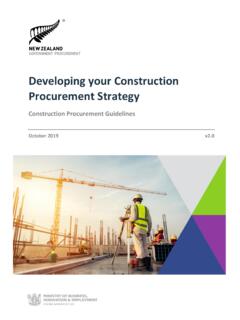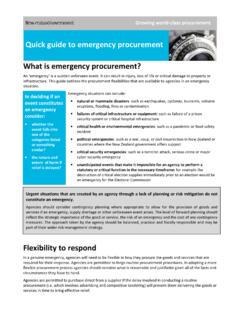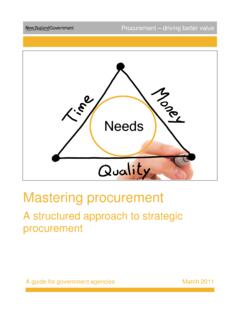Transcription of Government Procurement Rules
1 Government Procurement RulesRules for sustainable and inclusive procurementNEW ZEALAND Government PROCUREMENTISBN: 978-0-478-43366-1 (Online)ISBN: 978-0-478-43367-8(Print)Published June 2019 [fourth edition] In force 1 October 2019 Published March 2015 [third edition] In force from 1 July 2015 to 30 September 2019 Published June 2014 [second edition] In force from 26 May 2014 to 30 June 2015 Published April 2013 [first edition] In force from 1 October 2013 to 25 May 2014 New Zealand Government Procurement Branch | Ministry of Business, Innovation & Employment (MBIE)PO Box 1473, Wellington 6140, New | COPYRIGHT 2019 This work is licensed under the Creative Commons Attribution-Non-commercial-Share Alike New Zealand Licence. In essence, you are free to copy, distribute and adapt the work non-commercially, as long as you attribute the work to The Crown, and abide by the other licence terms. To view a copy of this licence, visit note that no departmental or governmental emblem, logo or Coat of Arms may be used in any way that infringes any provision of the Flags, Emblems, and Names Protection Act 1981.
2 Attribution to The Crown should be in written form and not by reproduction of any such emblem, logo or Coat of 1 Government Procurement RULESC ontentsForeword ..3 Context ..4 What are the Rules ? ..4 Editions ..4 What is Procurement ? ..4 Application to agencies ..5 How to use the Rules ..5Te Tiriti o Waitangi/Treaty of Waitangi ..6 For more information ..6 SECTION 1: GETTING STARTED 7 Why have Rules ? ..8 What is good Procurement ? ..10 The Five Principles and the Government Procurement ..12 Government Procurement Charter ..13 Rule 1: Principles and the Government 2: Integrity ..15 Rule 3: Non-discrimination and offsets ..15 Rule 4: Protection of supplier s information ..16 Rule 5: Who the Rules apply to ..17 Rule 6: When the Rules apply goods or services or refurbishment works ..18 Rule 7: When the Rules apply new construction works ..19 Rule 8: Estimating the monetary value of a Procurement ..20 Rule 9: Non-avoidance.
3 21 Rule 10: Types of contract ..21 Rule 11: Non- Procurement activities ..22 Rule 12: Opt-out procurements ..23 Rule 12A: Procurement response measure ..24 Rule 13: Requirement to openly advertise ..25 Rule 14: Exemption from open advertising ..26 SECTION 2: PLANNING YOUR Procurement 31 Rule 15: Planning ..32 Rule 16: Broader Outcomes ..33 Rule 17: Increase access for New Zealand businesses ..34 Rule 18: Construction skills and training ..35 Rule 18A: Quality employment outcomes ..36 Rule 19: Improving conditions for New Zealand workers ..36 Rule 20: Transitioning to a net-zero emissions economy and designing waste out of the system ..37 Rule 21: Annual Procurement Plans ..37 Rule 22: Significant Procurement Plans ..38 Rule 23: Third party agents ..38 Rule 24: Procurement advice ..39 Rule 25: Subcontracting ..39 Rule 26: Delivery date ..39 Rule 27: Technical specifications ..40 Rule 28: Pre-conditions ..41 Rule 29: Sufficient time.
4 42 Rule 30: Minimum time periods ..43 Rule 31: Allowable reductions ..43 Rule 32: Business day ..44 Rule 33: Fair application of time ..44 Rule 34: Minimum time periods by process ..45 SECTION 3: APPROACHING THE MARKET 47 Rule 35: Open advertising ..48 Rule 36: GETS listing ..48 Rule 37: Notice of Procurement ..49 Rule 38: Content of Notice of Procurement ..50 Rule 39: Other tender documents ..52 Rule 40: Responding to queries ..52 Rule 41: Additional information ..53 Rule 42: Changes to process or requirements ..53 Rule 43: Treatment of responses ..54 Rule 44: Reasons to exclude a supplier ..55 Rule 45: E-auction ..56 PAGE 2 NEW ZEALAND Government PROCUREMENTSECTION 4: AWARDING THE CONTRACT 57 Rule 46: Awarding the contract ..58 Rule 47: Informing suppliers of the decision ..59 Rule 48: Contract Award Notice ..59 Rule 49: Debriefing suppliers ..60 Rule 50: Supplier complaints ..61 Rule 51: Prompt payment ..62 Rule 52: Maintaining records.
5 63 Rule 53: Reporting ..63 Rule 54: Audit ..64 SECTION 5: TYPES OF SUPPLIER LISTS 65 Rule 55: Types of supplier 56: Pre-qualified Suppliers List ..66 Rule 57: Panel of Suppliers ..68 SECTION 6: OTHER Rules YOU NEED TO KNOW 71 Rule 58: All-of- Government Contracts ..72 Rule 59: Syndicated Contracts ..72 Rule 60: Common Capability Contracts ..73 Rule 61: Web standards ..75 Rule 62: Approved Government Model Templates ..75 Rule 63: Intellectual property ..76 Rule 64: Infrastructure ..77 Rule 65: Business cases and investment decisions ..77 Rule 66: Investment reviews ..78 Rule 67: Timber and wood products ..78 Rule 68: Employee transfer costs ..79 Rule 69: Planning for new construction works ..79 Rule 70: Procurement Capability Index ..80 Rule 71: Significant Service Contracts Framework ..80 SECTION 7: DEFINITIONS 81 Table of Rule changes ..96 PAGE 3 Government Procurement RULESF orewordAs the Procurement Functional Leader, I am pleased to introduce the Government Procurement Rules , fourth edition.
6 Government Procurement can make a vital contribution to the wellbeing of New Zealanders. Benefits that go beyond the immediate purchase of goods, services and works for Government can now be achieved through our collective spend in order to ensure that we are promoting inclusivity, transparency and sustainability in the Procurement Rules are essential in reforming Government Procurement to support broader social, economic, cultural and environmental outcomes, as well as continuing to represent the Government s standards of good practice during the Procurement these Rules , Government contracts will now be more explicitly leveraged to support broader outcomes. This entails leveraging contracts to promote the transition to a net zero emissions economy, supporting New Zealand businesses, promoting skills development, and ensuring compliance with employment and health and safety standards. As Government , we will take a lead in ensuring that our spend is delivering public value for New Zealanders.
7 Government Procurement can also future-proof the ability of New Zealand business to trade. By seeking continual innovation and requiring high standards in the Procurement process, we are ensuring that those who win contracts in New Zealand can compete in the international market. This increases exports and supports New Zealand s economic growth. Procurement must adapt and stay relevant to the changing needs of society, the economy and the environment. The inclusion of these wider Procurement benefits will ensure Procurement practice in New Zealand remains flexible and productive in relation to global trends. Carolyn TremainChief Executive, Ministry of Business, Innovation and EmploymentPAGE 4 NEW ZEALAND Government PROCUREMENTC ontextWhat are the Rules ?The Government Procurement Rules are the Government s standards of good practice for Government Procurement . They are the paragraphs numbered 1 to 71, in Sections 1 to 6 of this document, and include the definitions in Section Rules must be read along with the Principles of Government Procurement , the Government Procurement Charter and other good practice guidance.
8 You can read more about these at: Rules were first published in October 2013, replacing the Mandatory Rules for Procurement by Departments issued by the Ministry of Economic Development in second edition of the Rules came into effect on 26 May 2014, to reflect Cabinet s decision to rescind the Rule that required agencies to source cleaning services only from members of the Building Services Contractors third edition came into force in July 2015 following a general review. Changes included extending the mandatory application of the Rules to a wider range of agencies, and amending Rules relating to opt-out procurements and Notices of fourth edition, now titled the Government Procurement Rules , has been developed to align with the Government s expectations that Procurement will be leveraged to achieve Broader Outcomes. Changes include: A transformation in the way public value is assessed and calculated with a wider view towards the Broader Outcomes that can be achieved through Procurement ( Rules 16 to 20).
9 A set of changes to construction Procurement ( Rules 18, 64 and 69). New Rules around Procurement capability ( Rules 70 and 71), reporting (Rule 53) and planning (Rule 15). The removal of outdated Rules (Extended Procurement Forecasts and Registered Suppliers Lists and amending requirements relating to Significant Procurement Plans). Amending the construction threshold to $9 million and reviewing the thresholds table at the end of this document explains changes to the numbering of the Rules from the third edition. The fourth edition has been approved by the Ministers of Finance and State Services and was endorsed by Cabinet on 13 May 2019. It applies from 1 October is Procurement ?The term Procurement covers all aspects of acquiring and delivering goods, services and works (refurbishment and new construction). It starts with identifying the need and finishes with either the end of a service contract or the end of the useful life and disposal of the asset.
10 This is called the Procurement lifecycle. You can obtain more information on the eight stages of the Procurement lifecycle at: can range from relatively simple and low risk activities to those that are complex and high risk. For procurements that are high risk or high value, a strategic approach will usually result in better outcomes. A strategic approach involves understanding the importance of the Procurement to the agency in achieving its outcomes, undertaking adequate planning, sourcing suppliers and managing relationships to successfully deliver against public policy objectives and business needs, while delivering public value means achieving the best possible result from a Procurement . For instance, Procurement offers the opportunity to support New Zealand businesses, including M ori businesses and Pasifika businesses. Procurement can also contribute positively towards achieving environmental outcomes by supporting New Zealand s transition to a low emissions economy or reducing waste.




